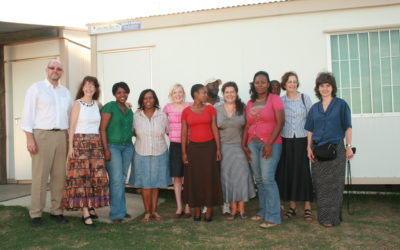News
Joint diagnosis of cervical cancer and female genital schistosomiasis, step 1.
See this 7-minute video for an overview (press link): Sub-Saharan girls and women at risk of Female Genital Schistosomiasis (FGS) are currently not being diagnosed or treated. Health care professionals require several weeks of training and there are only a handful of professionals who are proficient in FGS diagnosis. We are now joining forces with the cervical cancer screening... read moreOne-stop-shop for FGS and cervical cancer screening?
“Health professionals do not know that bloody discharge, smelly discharge, pain when you have sex or infertility may be caused by Female Genital Schistosomiasis (FGS)”, the conference participants heard at the virtual IPVC (International Papillomavirus Conference, Toronto November 16-23, 2021 ). “Currently these women are treated mistakenly as though they have cancer or as if they have a sexually transmitted disease, but women and girls may have FGS instead. Their daughters and sisters who use the same source of water for domestic purposes will make up a new generation of women with the same problem, wrongly diagnosed, untreated, misinformed and suffering. For the first time, we are suggesting to pair the diagnosis of cervical cancer and FGS in the same programme, elevating the standard of care.” FGS is a variant of Bilharzia, Schistosoma haematobium, transmitted in fresh water in Africa. The disease lasts for a lifetime. Please listen to world experts in cervical cancer and FGS who are teaming... read moreBRIGHT Academy
BRIGHT Academy is an umbrella organisation for 8 research and health institutions that have focused on Female Genital Schistosomiasis (FGS) since the 1990’s, its researchers are at the forefront of FGS research. They were the first to show an association between FGS and HIV, did the first community-based study on fertility and FGS, showed that children have FGS, and found an association between HPV and FGS. Currently the focus of BRIGHT Academy is on transfer of knowledge to health professionals and management of... read moreFemale Genital Schistosomiasis lesions explored using Circulating Anodic Antigen (CAA) as an indicator for living schistosoma worms
Nemungadi TG, Kleppa E, van Dam GJ, Corstjens PLAM, Galappaththi-Arachchige HN, Pillay P, Gundersen SG, Vennervald BJ, Ndhlovu PD, Taylor M, Naidoo S, Kjetland EF
In schistosomiasis endemic areas of South Africa, genital grainy sandy patches and abnormal blood vessels are found more commonly in women who harbour live Schistosoma haematobium worms whilst homogenous yellow patches indicate chronic tissue damage due to dead ova.
Mapping Schistosoma haematobium for Novel Interventions against Female Genital Schistosomiasis and Associated HIV Risk in KwaZulu-Natal, South Africa
Mahala Livingston, Pavitra Pillay, Siphosenkosi Gift Zulu, Leiv Sandvik, Jane Dene Kvalsvig, Silindile Gagai, Hashini Nilushika Galappaththi-Arachchige, Elisabeth Kleppa, Patricia Ndhlovu, Birgitte Vennervald, Svein Gunnar Gundersen, Myra Taylor, Eyrun F Kjetland
Women with female genital schistosomiasis (FGS, Bilharzia) have been found to have genital symptoms and a 3-fold higher risk of HIV infection. In South Africa, in KwaZulu-Natal rural schools, this study indicates that Bilharzia treatment could prevent genital symptoms in more than 200,000 young women. Furthermore, it is feasible that more than 5,000 HIV infections could be prevented in adolescent girls and young women by treatment and prevention of Bilharzia.
Detection of Schistosoma DNA in genital specimens and urine: A comparison between five female African study populations originating from S. haematobium and/or S. mansoni endemic areas.
Pillay P, Downs JA, Changalucha JM, Brienen EAT, Ramarokoto CE, Leutscher PDC, Vennervald BJ, Taylor M, Kjetland EF, Van Lieshout L. Acta Trop. 2020;204:105363.
Female Genital Schistosomiasis (FGS) is a neglected disease affecting millions, however challenging to diagnose. This explorative descriptive study compares Schistosoma real-time PCR analysis of cervico-vaginal lavages (CVL) with corresponding urine and stool samples of 933 women from five different previously described study populations. Sampling included 310 women from an S. mansoni endemic region in Mwanza, Tanzania and 112 women from a nearby S. haematobium endemic region. Findings were compared with samples collected from S. haematobium endemic regions in South Africa from 394 women and from 117 women from Madagascar of which 79 were urine pre-selected microscopy positive cases from highly-endemic communities and 38 were urine microscopy negatives from a low-endemic community.
As anticipated, urine and stool microscopy and gynecological investigations varied substantially between study populations; however, the same Schistosoma real-time PCR was performed in one reference laboratory. Schistosoma DNA was detected in 13% (120/933) of the CVL, ranging from 3% in the S. mansoni Tanzanian endemic region to 61% in the pre-selected Malagasy urine microscopy positive cases. Detectable Schistosoma DNA in CVL was associated with Schistosoma DNA in urine but not with microscopic detection of eggs in urine or by cytological examination.
This study confirmed real-time PCR for the detection of Schistosoma DNA in gynecological samples to be a valuable diagnostic tool to study the distribution of FGS within schistosomiasis endemic areas.


